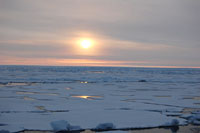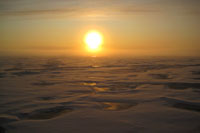

 | |||||||||||||||||||
|
|
Journals 2009/2010Jonathan Pazol
August 26, 2009 The multibeam echosounder data for yesterday's newly discovered seamount has been processed and put into the Fledermaus program. The Science Party is still debating the name. Suggestions are always welcome. It is just over 1000 meters tall (.6 miles), which means it fits the geological definition of a seamount. Below, a 3D, color banded image displays it from one angle and shows it peaking at a height of about -2622.20 meters (-1.57 miles) below the surface of the ocean. So no, we were not able to see it, and without the multibeam, we would have never known it was there. Like many things in science (DNA structure, chemical bonding, nuclear fission, etc.), we have to rely on indirect observations, rather than direct ones we make with our eyes. As an endorsement for sending teachers on programs like the ARMADA Project, yesterday's discovery provides support. In addition to making connections to oceanography for our students, we are also actively participating in the research. The initial change in the depth of the sea floor was first noticed by Chris Hedge, the "NOAA Teacher at Sea," while she was doing her watch. She notified Co-Chief Scientist Andy Armstrong, who then had the Healy rerouted, so that we could map it more fully.
Before I came to the Arctic, I had lots of questions about what being on the ocean was going be like. Many people, myself included, assumed that the sea conditions might be like those seen on the TV show, Deadliest Catch, which follows crab fishing boats in the Bering Sea. Or they would be like on Whale Wars, which is set in Antarctica. Both of these programs show smaller ships pitching and rolling in rough waves, icy conditions, sleet, darkness, etc. Fortunately, the weather and water have been nothing like this. The Arctic Ocean, especially once you're in the ice, tends to be much calmer. (I probably would have been sick for days if it hadn't).
Also several people, especially my brother who is an avid fisherman, wanted to know if I was going to bring some fishing gear with me, so that I could catch crabs or fish from the side of the ship. Well, I would like to set the record straight. As far as crabs, our water depth is regularly at 3700 meters (2.2 miles), which is way too deep for crabbing. The Healy is huge, so the only place to logically fish would be off the fantail (back), which is where scientific equipment gets deployed at various times through the day or night. Second, as we've headed further north, the ice has become very thick, and I don't think we'd be pulling over so that I could drill a hole in the ice. Third and most important, the main type of fish in this area is Arctic cod. They do not grow very large. We did actually catch one in our science ballast tanks. It was no more than 10 centimeters (4 inches), but it would not have made for very good eating. I did find out that on the trip from Seattle around Alaska, the crew does get a chance to fish.
People also want to know if it's been difficult for me to be on watch from midnight until 8 am. I think that if I was anywhere but in the Arctic, this would be more of a challenge. I have never had to work the "night shift," where it is getting dark when you go to work and getting light when you leave (although I've spent enough years teaching in the Chicago area where it is dark when you arrive at school and dark when you go home), but I imagine it would be difficult. During the Arctic summer, it is hard to tell the difference. Here are two pictures, one taken at "sunrise," and the other taken at "sunset" - can you tell the difference?
|
||||||||||||||||||




